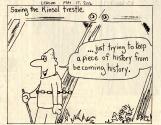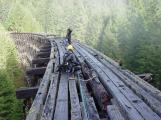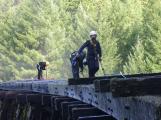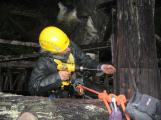1
As early as 1971, the Parks Branch of the Province of BC was considering the future use of the CN right-of-way on Vancouver Island. This was long before the last train crossed the railway bridge in 1979. In 1973, Don Tarasoff, working for the Ministry of Government Services, Heritage Branch of BC, was asked to prepare a report about the recreational potential of the CN right-of-way. When asked about the report he said, "The first time I came across the Kinsol Trestle - this was about four decades ago, the Parks Branch, the Provincial Parks Branch in Victoria, was looking at a linear parkway way from Victoria to Youbou, going along what was the old CNR right-of-way, which included the Kinsol Trestle so we looked at the Kinsol Trestle, did the history and it's in the report. So that was the first kind of interest on the provincial side in the Kinsol Trestle."In the early 1980s, those interested in preserving the Kinsol Trestle as a heritage site wrote to the provincial and federal governments requesting that the trestle receive official heritage designation. The Cowichan Leader has been a long-time advocate of preserving the Kinsol Trestle. Under the headline "Trestle In Jeopardy," an article in its August 31, 1982, edition read, "This easily accessible and valuable piece of our railroading heritage deserves better protection than it has been getting." If it takes an act of the CVRD in declaring it a heritage site or if it takes provincial involvement, the trestle should not be allowed to be deliberately pulled down. By sitting back and allowing the destruction of this remarkable example of the wooden trestles that opened the country up to settlement, we all become accomplices of the crew that is pulling out the spikes."
Early advocates such as Jack Fleetwood, Richard Pope (past President of the Vancouver Island Industrial Heritage Society) and reporter Dave Marsden spent much time and energy promoting a heritage designation for the trestle and campaigning for its preservation.
In 1984, the provincial government commissioned a report to determine the feasibility of giving the trestle heritage designation. In this intergovernmental memorandum, the background, history, cost estimates and heritage value of the Kinsol Trestle were discussed, along with recommendations for its future use. The memorandum was generated in response to the urging of concerned citizens and a local newspaper (the Cowichan Leader) to preserve the railway bridge "as both a heritage object and a tourist attraction." At that time, the cost for refurbishing the trestle was estimated to be $360,000, and the annual maintenance fees were projected to be approximately $35,000.
The memorandum discussed options for the government to consider and noted that not only would a great deal of money be required for the preservation of the trestle, under the Heritage Conservation Act, but also the government would be seen to have a moral obligation to refurbish and maintain it. Taking into account the fiscal restraint program in place at that time, the Kinsol Trestle was not considered to be a priority. The designation of the Kinsol Trestle was not recommended; instead, a "Notification of Interest - Extended Term" was placed on it. This news was reflected in the June 7, 1984, edition of the Cowichan Leader: "The Provincial Government has indicated it won't designate the Kinsol Trestle a heritage site, but does agree it's worth preserving...The province will place a notation of interest on the trestle following the transfer of ownership from CNR, Provincial Secretary Jim Chabot said in a letter to Leader reporter David Marsden this week."
2
Cowichan Leader editorial cartoon depicting local passion for saving Trestle17 May 2006
Kinsol Trestle, Cowichan Valley, Vancouver Island, BC Canada
 Credits:
Credits:Cowichan Leader Newspaper
3
The story of the Kinsol Trestle is as much about preserving an individual structure of historic significance as it is about how heritage has been defined. The standards by which a person, place, event or structure is determined to be "historic" or "heritage" have changed. For example, when proponents of the trestle sought heritage designation from both the federal and provincial governments in the early 1980s, and again in the 1990s, the standards for determining heritage values excluded the trestle because it was not deemed to be a unique example of railway engineering. In fact, it was considered "representative" and therefore not eligible for heritage designation.The Cowichan Leader noted in a March 21, 1990, article that "Shawnigan Lake resident Richard Pope is frantically trying to organize a society to save three historic bridges in the Shawnigan Lake / Renfrew area. He wants bridges preserved as historical artifacts of the logging industry and as tourist attractions.
AUDIO: Richard Pope
...I brought from Vancouver a fellow who was North America's (I didn't know he was) he's the premier engineer for suspension bridges. He was the person that, I think it was the 1995 earthquake in San Francisco, he actually went down and inspected the Golden Gate Bridge to make sure it was safe...I had just heard about him from a friend...I phoned and talked to him, and he came over. We spent about three hours at the Kinsol Trestle, and actually walked through the structure, on the sleepers, through the whole thing, and what he did, he had an awl, and just did tests of the timbers, and would be saying, "This one's sound, this one would have to be replaced." There was no written report or anything like that, just he was interested at the time...he said the Howe truss structure, down at the bottom, he said if you do nothing, and if what's over top of it doesn't collapse on top of it, this will outlast you. It's very well made. It's on concrete piers, it's great. The rest of it, he said, you're going to have to do something...and to start with, he said to clear around the bases of all the bents. So immediately the next day I went with Nicholas, my son, who was about eight or nine at the time, and we started on the Glen Eagles Rd. side with a shovel, a small chainsaw, and cleared, made our way. Didn't do it all in one day, but made our way down to the river....I would cut any trees that were growing through the structure and then we went around Riverside Road another time and made our way down to the bottom just, clearing away from at the bents and would cut the always hoping that no one was going to come by and (laughing) see me doing that.
4
Richard Pope speaking on bringing in expert consultant6 October 2010
Kinsol Trestle, Cowichan Valley, Vancouver Island, BC Canada
 Credits:
Credits:Richard Pope, Speaker
Shawnigan Lake Historical Society
5
In the early 1990s, the Cowichan and Chemainus Valleys Eco-museum Society also sought heritage designation of the Kinsol Trestle. This work began with a tourism initiative to create an inventory of heritage sites in 1989 which included interpretation of the Kinsol Trestle. When Eco-museum Society Chairperson Jean Brown received a response to the Society's letter requesting heritage designation for the Kinsol, the news was not good. The November 16, 1992, letter from the Executive Secretary of Historic Sites and Monuments Board of Canada noted that they had discussed the potential national significance designation for the trestle. The letter notes: "Following some discussion, the board recommended that, while it is representative of large scale 19th century railway trestles in North America, the technology used in the construction of the Koksilah River or Kinsol Trestle was well established when it was built and the Trestle could not be seen to be of national historic significance as an engineer work."The Society brought together heritage experts and members of the community for a Kinsol Trestle planning workshop, held on February 26, 2000. The February 23, 2000, edition of the Cowichan Valley Citizen newspaper reported on the upcoming workshop: "Forum to discuss restoring Kinsol Trestle - The Cowichan Valley Regional District and the Eco-museum Society will hold a forum focused on restoring the Kinsol Trestle next weekend. Guest speakers at the forum will include CVRD development services manager Tom Anderson, historian and author Bob Turner, structural engineer Martin Holden, Heritage Society of B.C. executive director Rick Goodacre and Trans Canada Trail project manager Brad Drew."
Wilma Wood, a founder of the Eco-museum Society, spearheaded the campaign to bring heritage experts and other stakeholders together to advocate for the preservation of the Kinsol Trestle and other important heritage sites in the Cowichan and Chemainus Valleys. Under her leadership, the Eco-museum Society issued a proposal, prepared by Murray Sager, to "explore the feasibility of the Eco-museum assuming a sub-lease on the approach to the Kinsol Trestle and sponsoring projects designed to improve visitor access and interpretation of the site." Again, in 2000, the news about the Kinsol was not good: "Trestle funding denied" reported the Cowichan Valley Citizen on May 28 and the August 27 edition of The Pictorial stated: "Trestle grant denied, but CVRD won't give up."
More reports were commissioned between 2000 and 2005, and the media continued to discuss the fate of the Kinsol Trestle. Headlines in Vancouver Island papers advocated, on the whole, for the preservation of the Kinsol - "Restore the Kinsol Trestle" (Times Colonist, September 3, 2004) "Kinsol Trestle gets good will, but not money" (The Pictorial, February 13, 2005) and "It would be a huge mistake to lose the Kinsol Trestle" (Cowichan News Leader "Comment - in our view" April 25, 2005).
6
Vegetation encroaches Trestle2006
Kinsol Trestle, Cowichan Valley, Vancouver Island, BC Canada
 Credits:
Credits:Shawnigan Lake Historical Society
7
In 2006, British Columbia's Ministry of Transportation announced it had earmarked $1.5 million to dismantle the Kinsol Trestle. The trestle's imminent demise accelerated discussion about its fate - in the media, in the community and amongst heritage specialists. Local historian T.W. Paterson recalled his reaction to the news about the MOT's announcement:AUDIO: T.W. Paterson
...I stewed over it for two weeks. I remember that John McKinley, the editor of the Cowichan Leader, as it was at that time, not the Cowichan News Leader Pictorial. Anyway, I've always given John McKinley full points for this because he came out with an editorial in response to all this news saying that this is wrong, that we should be out to save the trestle, not out to destroy it. And I had been, you know, ruminating on it and so he was the catalyst that made me think, I've got to at least try.
Jean Crowder, MP (Nanaimo-Cowichan) is a long-time supporter of the Kinsol Trestle. On June 13, 2006, she presented the following motion in the House of Commons:
M-194 Ms. Crowder (Nanaimo-Cowichan) -
"That, in the opinion of the House, the government should designate the historic Kinsol Trestle a heritage site and provide resources to safely restore it to its pre-eminent position as one of the largest wooden railway trestles in Canada and a crucial link point for the Trans Canada Trail."
In 2007, John Horgan, then Malahat-Juan de Fuca MLA, presented a petition to save the Kinsol Trestle to the legislature. The petition had more than 12,000 signatures.
The announcement to demolish the Kinsol Trestle inspired a summer exhibition at the Cowichan Valley Museum & Archives entitled: "Kinsol in Crisis: Past. Present. Future?" A history of the trestle was featured, along with a collection of artefacts found in situ that were related to the people who lived and worked near the site of the trestle. Visitors to the exhibit were invited to record their thoughts and comments about the potential demise of the Kinsol. The vast majority were in favour of preserving it, with comments like, "Save the Trestle" and "If the bridge were in Europe it would automatically be saved." Tourists make up the majority of visitors to the museum during the summer months, but that year, a substantial number of local residents came in - some of whom, even though they had lived in the Cowichan Valley all their lives, they had never seen the trestle.
In the summer of 2006, Ralph Morris, CN Engineer (retired), visited the Cowichan Valley Museum & Archives and made a significant donation of archival material that was useful to the work undertaken by the Macdonald & Lawrence Timber Framing Co. and Commonwealth Heritage Resource Management. Ralph believed that the Kinsol was not beyond saving. This archival material contained drawings, slides, photographs, field notes and correspondence and became a resource for the rehabilitation team. Ralph became a consultant for the rehabilitation project.
8
Trestle studies conducted by Macdonald & Lawrence16 November 2007
Kinsol Trestle, Cowichan Valley, Vancouver Island, BC Canada
 Credits:
Credits:Cowichan Valley Museum & Archives
Macdonald & Lawrence Timber Framing photo credit
9
The spring, 2007 edition of the Heritage BC Quarterly featured an article by Heritage BC Executive Director Rick Goodacre, who wrote about the need for a Crown Heritage Stewardship Policy and argued that,"Senior government should set standards and shape policies, enact a legal framework and provide resources through programs, funding and expertise. Provincial and federal governments should exemplify the highest heritage principles and best practices...the B.C. provincial government last summer committed $1.5 million to demolish the magnificent Kinsol Trestle near Shawnigan Lake, which it has owned, and neglected, since 1979. More recently, the Premier announced another $1.6 million to help build a replacement.
The Kinsol Trestle issue prompted Heritage BC to write to the Provincial Heritage Minister and ask when we can expect to see a provincial Crown Heritage Stewardship policy. The Heritage Conservation Act of 1977 had anticipated this question and empowered the Heritage Minister to create such a policy. Thirty years on, we are still waiting. While there have been a few tenuous efforts from time to time, there has been little real progress..."
Up until 2007, the issue of preserving the Kinsol Trestle had been debated many times, but local government was still at an impasse. The reports submitted by Macdonald & Lawrence, and Commonwealth Heritage Resource Management, created an opportunity for the CVRD to look at the trestle in a new way. MacDonald & Lawrence brought something unique to the table: the expertise to determine the feasibility of conserving the Kinsol Trestle by assessing its structural integrity. They also brought with them a stellar reputation. In his interview, Gordon Macdonald discussed this new approach and said,
AUDIO: Gordon Macdonald
...I guess the trick with these things is if you don't ask the right questions in the first instance it's very difficult to get the right answer. So the CVRD, with the best intentions in the world, had been asking, and the MOT as well, consistently asking the wrong question, with good intentions and the question they were posing was, what will it take to fix the Kinsol and is it realistic do that and if so, what would it cost. And it never really occurred to anyone to ask the question, "What is the minimum that could be done in order to conserve the Kinsol and preserve it." And it seems a subtle difference, but it's a really important one. When you approach a task of that enormity, from the perspective of "fixing" it, and your client, the person who's asking you, is a department of the provincial government, you want to give a fairly robust answer and one that is quite safe and conservative. If you turn the question around and you ask instead, how can we conserve this important bit of our history, or our cultural history, then it kind of frees you up to look at it from a slightly different perspective, and different options present themselves. So we would lay out three or four options…and also what was most likely to deliver the end use that they were after, because they were quite specific about what they wanted to use the bridge for. That's important in this equation, because it's not just a heritage object, it has a purpose, and we knew that unless we could really deliver the working goods, and make it appropriate for that purpose, the project was never going to go anywhere. That is the key to most successful conservation projects on a large scale. Unless you can provide cultural relevance and use as a place, objects are static and it's very difficult to convince people to throw money at them, and we're just fortunate in this instance that we have this really quite lovely object which is absolutely useless in terms of purpose unless it is rehabilitated…it's possible that in the instance of the Kinsol to enable that use which is part of the Trans Canada Trail network and as a pedestrian/equestrian crossing, in such a way that respects the history of the place, and that really is quite easily accomplished there.
In 2008, Commonwealth Historic Resource Management's findings showed that rehabilitation of the trestle could be a viable option and the CVRD decided to proceed with Phase 2 of the Kinsol Trestle Restoration Feasibility Study. By the spring, $4.1 million dollars of funding was in place, but more was required to complete the project.
10
Gordon Macdonald discusses approach to conservation of Trestle26 November 2010
Kinsol Trestle, Cowichan Valley, Vancouver Island, BC Canada
 Credits:
Credits:Gordon Madonald, Speaker
Cowichan Valley Museum and Archives
11
Trestle studies conducted by Macdonald & Lawrence2007
Kinsol Trestle, Cowichan Valley, Vancouver Island, BC Canada
 Credits:
Credits:Cowichan Valley Museum & Archives
Macdonald & Lawrence Timber Framing, photo credit
12
Jack Peake is a long-time advocate of conserving the Kinsol Trestle. As a councillor and one-time Chair of the CVRD, he oversaw dozens of debates about the feasibility of saving the trestle as a link in the Trans Canada Trail and as a symbol of our industrial past. Jack saw the economic possibilities for the Cowichan Valley in a conserved Kinsol Trestle and fought hard to overcome many negative attitudes and fears held by others.Jack is now the Chair of the Kinsol Capital Fundraising Campaign. In an article he authored for the November 26, 2010 edition of the Cowichan Valley Citizen, he wrote, "As I stated when I agreed to take this on, there aren't many opportunities in a lifetime to make a difference for generations to come. But rehabilitating the Kinsol Trestle is one of those chances for me and everyone else involved in the effort...in the years ahead, our children's children will be walking across the trestle, staring down at the Koksilah River through the graceful curve and weathered beams and being told of the industry, skills, and audacity and sheer tenacity of those who built this engineering marvel in the wilderness."
13
Trestle studies conducted by Macdonald & Lawrence2007
Kinsol Trestle, Cowichan Valley, Vancouver Island, BC Canada
 Credits:
Credits:Cowichan Valley Museum & Archives
Macdonald & Lawrence Timber Framing, photo credit